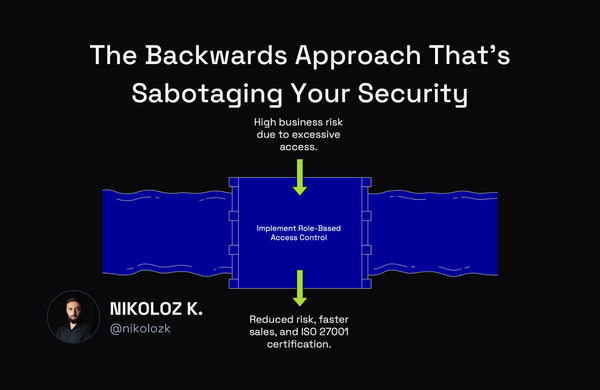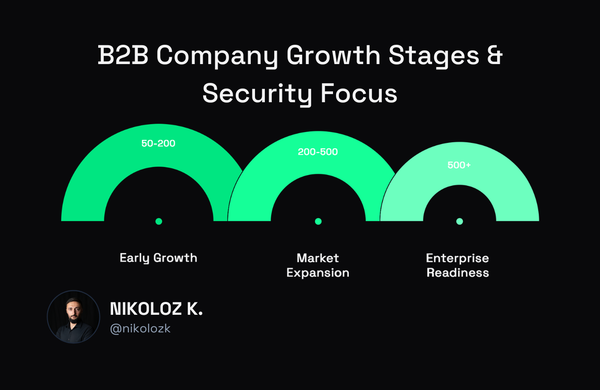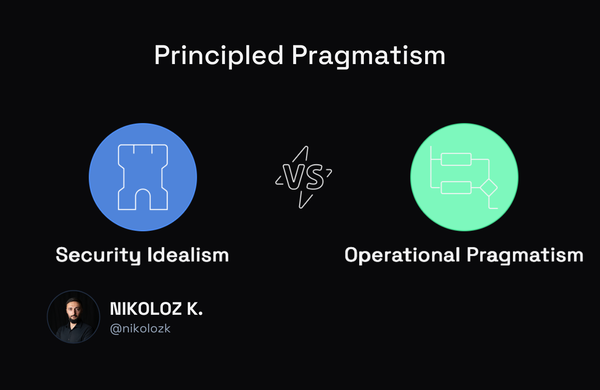Understanding DORA Regulation: A Guide for CISOs

Nikoloz Kokhreidze
Comprehensive guide to the Digital Operational Resilience Act (DORA) for the EU financial sector. Learn about DORA's objectives and impact on your organization.

The Digital Operational Resilience Act (DORA) is a significant European legislation that aims to strengthen the digital operational resilience of the EU financial sector. It is designed to address the increasing digital operational and security risks that financial entities face. In this article, you will learn about the key objectives of DORA regulation and whether your organization is impacted when it comes into force. Ultimately, I will provide a step-by-step guide on preparing your organization to comply with Digital Operational Resilience Act (DORA).
What Is the Purpose of the DORA Regulation?
DORA aims to establish a comprehensive framework to enhance the digital operational resilience of the EU financial sector and mitigate potential risks coming from digital disruptions. It seeks to achieve this by setting uniform EU rules for financial entities.
Firstly, DORA is striving to harmonize ICT risk management across all EU financial institutions. The goal here is to establish a standardized approach, setting clear expectations for acceptable risk levels and identifying critical functions.
Secondly, DORA is implementing a new framework for classifying and reporting ICT incidents. This is a significant step forward as it can help organizations enhance their ability to collect, analyze, and share information about ICT incidents and threats.
Moreover, DORA mandates annual resilience testing. This requirement ensures that organizations are regularly testing the security of their systems and assessing their resilience to disruptions.
In addition, DORA is expanding its scope to include all ICT service providers, not just Cloud Service Providers. This expansion means that all ICT providers your organization works with need to comply with DORA's requirements.
The regulation is maintaining an oversight framework, with the European Supervisory Authorities (ESAs) retaining their new oversight powers. This means that "critical" third-party providers will be closely monitored and regulated.
DORA also addresses ICT concentration risk by advocating for a collective approach at the Union level. This approach aims to manage potential issues that could arise due to ICT concentration risk.
In terms of financial stability, DORA is working to bolster the digital operational resilience of the financial sector. This effort is crucial for preserving the stability and integrity of the EU financial markets.
Lastly, DORA is designed to work in tandem with the NIS2 directive. This collaboration provides a baseline for cybersecurity risk management and reporting obligations.
In essence, DORA is a comprehensive framework designed to enhance the resilience of the EU financial sector and mitigate potential risks arising from digital disruptions. It's a significant step forward in managing ICT risks, reporting incidents, conducting testing, and managing third-party dependencies.
As you can see, DORA is designed to ensure that the financial sector can withstand operational outages, preserve the stability and integrity of the Union financial markets, and provide a high level of protection for investors and consumers. It does this by setting out a comprehensive and harmonized set of rules for ICT risk management, incident reporting, testing, and third-party dependencies.
Who Is Impacted by DORA Regulation?
DORA applies to various organizations operating within the European Union's financial sector. This includes but is not limited to:
- Credit institutions
- Investment firms
- Crypto-asset service providers
- Third-party ICT service providers
- Account information service providers
- Electronic money institutions
- Payment institutions
DORA's digital operational resilience rules take into account the differences between financial entities based on their size and risk profile. Financial entities should balance their ICT-related needs with their size, overall risk profile, and the nature, scale, and complexity of their services. Some financial entities benefit from exemptions or a light regulatory framework. Larger financial entities should establish more complex governance arrangements. The legislation also includes provisions for ICT third-party service providers. The Oversight Framework applies only to critical ICT third-party service providers based on criteria to determine their criticality. DORA applies to a broad range of organizations in the EU's financial sector, but requirements and expectations vary depending on the organization's size, nature, and risk profile.
When Will the DORA Regulation Be Effective?
The Digital Operational Resilience Act (DORA) will be effective from 17 January 2025. However, organizations must start preparing for it as early as possible due to the comprehensive changes it introduces.
How Can Your Organization Prepare for Compliancy with DORA Regulation?
In this paragraph, I will share some important steps that you need to consider when preparing your organization for DORA compliance.
Understand the DORA Regulation
The first step is to understand the DORA regulation and how it works. This includes understanding the requirements and the potential impact on your organization.
Legislation Review
Begin by thoroughly examining the DORA legislation available on the European Union's official website. This will provide a clear understanding of the obligations and requirements.
Legal Consultation
Engage with your organization's legal and compliance teams to better understand DORA's impact on your operations. They can offer valuable insights into its legal and regulatory aspects.
Industry Interaction
Join industry groups and forums to gain insights into DORA interpretation and implementation by other organizations. These platforms often facilitate discussions and resource sharing related to DORA.
Educational Opportunities
Attend DORA-focused webinars and training sessions offered by regulatory bodies, consulting firms, and industry groups. These can deepen your understanding of the legislation and provide practical compliance guidance.
External Consultation
If needed, reach out to external consultants specializing in DORA compliance. They can offer expert advice on understanding and implementing the legislation.
Regulatory Updates
Stay updated with any changes to the legislation by regularly monitoring amendments or clarifications from regulatory bodies.
Implementation Planning
With a solid understanding of DORA, plan to implement changes in your ICT risk management, incident reporting, resilience testing, and third-party risk management practices.
Is Security Blocking Your Next Enterprise Deal?
Let's discuss how fractional CISO services can unlock your pipeline without the full-time overhead.
Assess Your Current State and Identify Gaps
To assess the current state in preparation for DORA compliance, you can take the following steps:
ICT Risk Management Review
Begin by assessing your current ICT risk management practices. This will help identify gaps in compliance, including risk tolerances for ICT disruptions, identification of critical functions, and asset and dependency mapping.
Incident Reporting Evaluation
With DORA introducing a new framework for ICT incident reporting, it's crucial to ensure your current Incident Reporting mechanisms align with this new structure.
Resilience Testing Assessment
Regular testing of ICT systems and applications is mandated by DORA. Evaluate your resilience testing procedures to ensure they are comprehensive and robust enough to meet these requirements.
Third-Party Risk Management Review
DORA broadens guidelines to include non-CSP ICT outsourcing. Review your current practices to ensure effective risk management associated with your ICT third-party service providers.
Gap Analysis
After reviewing current practices, conduct a gap analysis to pinpoint areas of non-compliance with DORA. This will aid in prioritizing efforts and formulating a plan to address these gaps.
Develop a Plan
Developing a plan to address the identified gaps for DORA compliance involves several steps. Here's what you need to consider:
Gap Prioritization
Recognize that not all gaps carry the same weight. Prioritize them based on their impact on DORA compliance and the effort needed to rectify them.
Action Definition
Outline the necessary actions to rectify each gap. This could mean enhancing ICT risk management practices, improving incident reporting mechanisms, bolstering resilience testing procedures, or strengthening third-party risk management.
Responsibility Assignment
Ensure accountability and progress tracking by assigning a specific person or team to each action.
Timeline Establishment
Set a realistic completion timeline for each action. This will aid in progress tracking and ensure timely DORA compliance.
Implement the Plan
Implementing the plan for DORA compliance involves a series of steps that organizations should follow:
Action Execution
Begin by implementing the actions outlined in your plan, ensuring clarity on responsibilities and deadlines. This might involve modifications to your ICT systems, processes, and procedures.
Staff Training
DORA compliance extends beyond systems and processes to people. Equip your staff with knowledge of DORA's new requirements, which may include training on updated ICT risk management practices, incident reporting mechanisms, resilience testing procedures, and third-party risk management.
Collaboration with Third-Party Service Providers
If your ICT services are outsourced, collaborate with these providers to ensure their DORA compliance. This might necessitate contract reviews, audits of their practices, or even a change of providers if required.
Progress Monitoring
Regularly check your progress during the implementation. If you're not on track, identify the reasons and devise strategies to get back on course.
Plan Adjustment
Don't hesitate to modify the plan if specific actions prove more complex or time-consuming than anticipated. The ultimate goal is DORA compliance, not rigid adherence to an unworkable plan.
External Assistance
If implementation proves challenging, consider seeking external help. Numerous consultants and service providers specialize in DORA compliance and can offer valuable support.
Engage with Regulators
Engaging with regulators is a crucial part of ensuring full compliance with DORA.
Regulatory Consultation
Actively participate in consultations on new or changing regulations held by regulators. This allows for a better understanding of the regulator's viewpoint, a platform to ask questions, and an opportunity to provide input.
Regular Reporting
DORA mandates regular reporting to regulators. Familiarize yourself with the reporting requirements and establish processes for timely data collection and report submission.
Open Communication
Foster a cooperative relationship with regulators. Discuss any DORA compliance concerns openly, as they can offer guidance and help resolve issues.
Staying Updated
Keep abreast of regulatory developments, including changes to DORA or other relevant regulations. This could involve subscribing to regulatory newsletters, attending conferences or webinars, or consulting a regulatory expert.
Approval for Major Changes
Regulatory approval may be necessary for significant changes affecting DORA compliance, such as outsourcing a critical ICT function. Understand the requirements and engage with the regulator early in the process, to avoid unnecessary obstacles on your journey to compliance.
Continuous Improvement
Continuous improvement is a crucial aspect of maintaining digital operational resilience.
Stay Current with ICT Updates
With technology and cyber threats evolving, it's essential to keep your ICT systems, processes, and procedures up-to-date. This might include adopting new technologies, enhancing cybersecurity measures, or refining data management practices.
Empower Your Staff
Your team plays a vital role in digital operational resilience. Ensure they're equipped with the latest best practices for ICT risk management, incident reporting, resilience testing, and third-party risk management through regular training.
Collaborate with Third-Party Service Providers
If your ICT services rely on third-party providers, strive for continuous improvement in their practices. Regular audits, training, resources, and collaborative development of new services can all contribute to this.
Learn from Incidents
Use any ICT-related incident as a learning opportunity. Analyze the cause, the fallout, and preventative measures for the future, then make necessary updates to your ICT systems, processes, and procedures.
Keep Up with Regulatory Developments
Stay informed about changes to DORA or other relevant regulations. Subscribing to regulatory newsletters, attending conferences or webinars, or working with a regulatory consultant can help you stay abreast of these changes.
Conclusion
The Digital Operational Resilience Act (DORA) is a significant step towards enhancing the digital resilience of the EU's financial sector. It sets a new standard for ICT risk management, incident reporting, resilience testing, and third-party risk management. While the legislation introduces comprehensive changes, your organization can successfully navigate this new regulatory landscape with a clear understanding of its requirements and a well-planned strategy.
Remember, DORA compliance is not a one-time effort but an ongoing process that requires continuous improvement and adaptation to evolving technology and cyber threats. By staying informed about regulatory developments, regularly reviewing and updating ICT systems, and fostering a culture of digital resilience, your organization can comply with DORA and enhance its overall operational resilience.



